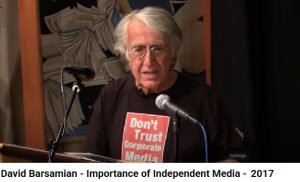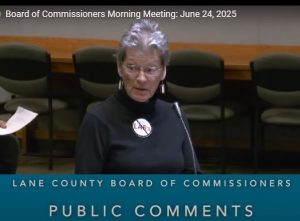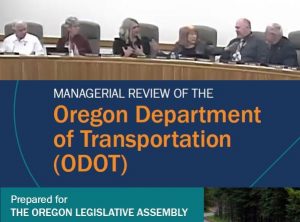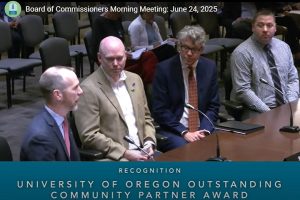Bethel hears DEQ plan to clean dioxins from residents’ yards by June 30
7 min read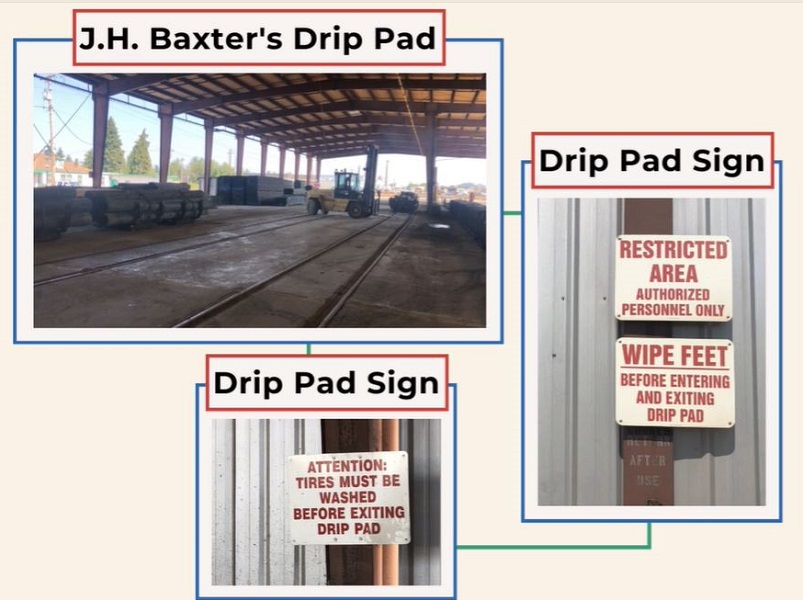
Bethel's neighborhood association played a key role in identifying dangerous toxins in residents' yards and Trainsong Park.
Oregon Health Authority to meet with Active Bethel Citizens March 1
Local and state officials told Active Bethel Citizens they plan to remove dangerous toxins from neighbors’ yards by June 30th.
[00:00:08] Leah Feldon: I’m Leah Feldon. I’m the deputy director at Oregon’s Department of Environmental Quality. And I’m really pleased to be joining you tonight. You’re going to hear a presentation about soil sampling that we’ve done in your community and that investigation and how we plan to address elevated levels of dioxins that have been found in some residential properties that are in close proximity to J. H. Baxter. And we want you to have the same information that we have.
[00:00:36] Travis Knudsen: My name is Travis Knudsen. I am the public affairs manager for the Lane Regional Air Protection Agency.
[00:00:43] John Q: Travis described a new website that collects a great deal of information about J.H. Baxter, called a StoryMap.
Thank you for supporting
local citizen journalism
[00:00:49] Travis Knudsen: This ArcGIS StoryMap goes into sources of pollution and it begins with air emissions. And this talks about some of the pollutants that come out of J.H. Baxter, particularly substances that they use to treat wood,
[00:01:03] Another aspect in the StoryMap details is soil contamination. It describes some of the elevated levels of arsenic, the PHSs (Particularly Hazardous Substances), PAHs (Polycyclic Aromatic Hydrocarbons), dioxins, and furans on the facility, it describes more in detail what some of these are and some of the efforts that have been done to correct these issues.
[00:01:22] We also have the 2020 soil sampling that was done. There’ve been two rounds of soil sampling but the first round took place in 2020, and this initial soil sampling is where dioxins were first discovered and is what caused the regulatory entities to look a little bit more closely at what’s going on. And this is what led into more recent soil sampling that was done in 2021, and is essentially the topic of tonight’s meeting.
[00:01:49] Susan Turnblom: My name is Susan Turnblom, I am the DEQ project manager for the J.H. Baxter cleanup site, and one of the main purposes of this meeting is to share with you all the sampling results that we collected from the sampling event that took place late last year.
[00:02:05] Seven residential yards were sampled in fall, and one was sampled in December, for a total of eight residential yards that were sampled last year. Six background locations were sampled last fall and one was sampled in December, and we collect the background samples as a means of comparing the site samples with. And two samples were also collected from on the J.H. Baxter property from the northern edge of the property.
[00:02:32] And how did we decide where to collect the samples? We used the Lane Regional Air Protection Agency’s predominant wind pattern analysis to determine where we wanted to sample. The wind blows mostly to the north and the south. And we focused of course on the north because that’s where the residences are. That’s where your homes are.
[00:02:52] We also sampled for classic chemicals called dioxins and furans, and this is why we’re all here this evening. Seven out of eight yards that were sampled had elevated levels of dioxins in them. And this is a concern for us. We are worried about the people who live and play in those yards.
[00:03:10] The samples collected from the J.H. Baxter property are high, they’re between 100 and 150 parts per trillion. Right across the street, Roosevelt Blvd., along the bank of that ditch there was lower, and the next closest are the residential yards. There’s a wide variety of concentrations, but there are three that are above 40 parts per trillion.
[00:03:34] Forty parts per trillion is the level DQ is using to prioritize cleanup that needs to happen quickly. This concentration is a level that’s protective of children six years and younger, who may be eating soil every day for more than a year. And that’s why we’re making sure that cleanup of these yards happens as soon as possible
[00:03:54] Keith Andersen: My name’s Keith Andersen. I’m the Western Region Administrator for the Department of Environmental Quality. One of the things that we anticipated doing with this investigation was stepping out in increments. Once we saw the sample results that came back from the September and October sample, and that was reported out in January, we realized that there’s a greater sense of urgency associated with this, given some of the levels that we’ve seen.
[00:04:19] We discussed this and we plan to be stepping out further than we had planned. But what we really want to do is find out where has this material come to be? Where is the dioxin at a level that is concerning?
[00:04:31] We have identified three properties that we’re really focused on cleaning up. We have other properties we know we’ll need something done, and we want to know, Where else do we need to be looking right now? We want to know, and we want to know soon where the contamination is, and then where we need to take action to do something about it.
[00:04:52] Mike Kucinski: My name is Mike Kucinski and I manage the Cleanup and Emergency Response program. When DEQ received the sample results in early January, showing the high levels of dioxin in residential yards, we requested Baxter conduct additional work, and we gave them a pretty short timeline to do it. They told us that they could not afford to pay for that work and so that they couldn’t do the work.
[00:05:15] And this is where DEQ’s High Priority Sites program comes in. It’s called our Industrial Orphan Site program and it provides funding for DEQ to do the work, but in order to access those funds, the responsible party must be unknown or unwilling to do the work or unable to pay for the work. So, because we because Baxter did not agree to do the work as we requested, we have determined that they are unwilling and we’re waiting for financial records from Baxter to determine if they are able to.
[00:05:49] And the term ‘orphan’ might cause you to think that Baxter can just walk away. But that is not the case. We will do everything we can to recover our costs and hold Baxter accountable. And one, one example of that is earlier today, DEQ filed a lien on the three parcels that make up the Baxter properties,
[00:06:07] John Q: Mike said they also asked for help from the Environmental Protection Agency.
[00:06:11] Mike Kucinski: Last week DEQ requested assistance from EPA. They can bring a lot of additional resources such as sampling, cleanup, and removal actions additional community engagement, as well as a lot of additional technical expertise that we can consult with. And we’re going to know more about EPA involvement next month in March.
[00:06:32] John Q: They expect to clean up the residential yards in May and June.
[00:06:37] Mike Kucinski: Our main priority at this time is to clean up residential properties with dioxin levels over 40 parts per trillion. Our target for completing the cleanup is June 30th. In the month of May and June, we will be conducting the actual cleanup and removal activities at the residential properties with dioxin levels over 40 parts per trillion. And then once we’ve addressed the properties with maximum levels, over 40 parts per trillion, we will turn our focus to the properties where dioxin levels between 4.7 parts per trillion and 40 parts per trillion and determine what the next steps are for those properties.
[00:07:16] John Q: The toxins in neighbors yards and at Trainsong Park might not have been found without the neighbors’ efforts. From Active Bethel Citizens, Lin Woodrich.
[00:07:24] Lin Woodrich: ABC was instrumental in the soil sampling and Susan can agree that there were only two of the homes that were agreeing to do the soil sampling. And they were saying, ‘Well, maybe it isn’t worth doing.’ And ‘Boots-On-The-Ground ABC’ went door to door and got the rest of the homes to sign up for the soil sampling. So it may never have happened if not for ABC.
[00:07:48] John Q: From Beyond Toxics, Lisa Arkin.
[00:07:50] Lisa Arkin: I’m really glad we’re partnering with ABC and DEQ to host this community meeting tonight. I’m Lisa Arkin, executive director of Beyond Toxics, and I just want to say this is a really unique and collaborative endeavor that has brought environmental protection regulators together with knowledgeable community advocates. And the whole purpose is to understand the depth of contamination at the JH Baxter site and to figure out its impact on the surrounding neighborhoods as we’ve been talking about tonight, and it’s an exciting new model of community engagement that, as far as I know, has not been tried elsewhere in Oregon….
[00:08:29] Beyond Toxics will continue to stand by the community. We’ll do everything necessary to ensure the community is treated with respect and is given every opportunity to regain clean air, healthy waterways, and safe soils, where kids can play in their own backyards and their own local parks.
[00:08:47] John Q: Bethel residents wondered why testing couldn’t start immediately.
[00:08:51] Kate: I know it takes a month and a half to get the sample back. So why are you guys waiting so long to possibly test residents in the area versus doing it now? Right? I’m not sure why.
[00:09:05] Mike Kucinski: That is a good question, Kate. And I think that one of the questions we need to answer is, where is it coming from? … If we find that it’s coming from air deposition, then that can definitely be something that covers a large area. It could have been pushed in from some other development but, you know, so, so we’re going to know in April whether we need to go out further into that neighborhood where you live or whether it, you know, there’s some other patterns within that area that was stable before.
[00:09:31] John Q: Next up, officials from the Oregon Health Authority will hold a virtual public meeting at 6 p.m. on March 1.
